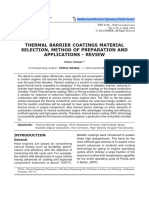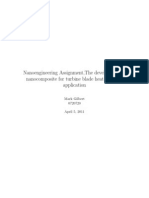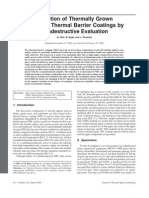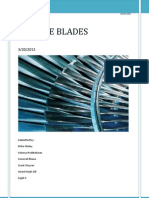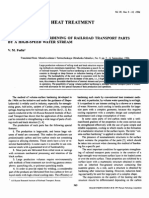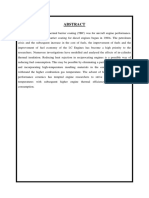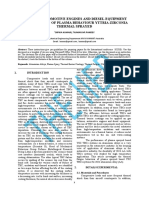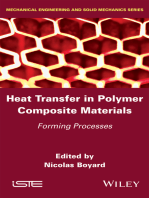Thermal Barrier Coating
Thermal Barrier Coating
Uploaded by
dafillyCopyright:
Available Formats
Thermal Barrier Coating
Thermal Barrier Coating
Uploaded by
dafillyOriginal Description:
Copyright
Available Formats
Share this document
Did you find this document useful?
Is this content inappropriate?
Copyright:
Available Formats
Thermal Barrier Coating
Thermal Barrier Coating
Uploaded by
dafillyCopyright:
Available Formats
Chapter 2 Thermal Barrier Coatings
2.1 Overview
By attaching an adherent layer of a low thermal conductivity material to the surface of a internally cooled gas turbine blade, a temperature drop can be induced across the thickness of the layer, Fig. 2.1. This results in a reduction in the metal temperature of the component to which it is applied. Using this approach temperature drops of up to 170oC at the metal surface have been estimated for 150 m thick yttria stabilized zirconia coatings[19]. This temperature drop reduces the (thermally activated) oxidation rate of the bond coat applied to metal components, and so delays failure by oxidation. It also retards the onset of thermally induced failure mechanisms (i.e. thermal fatigue) that contribute to component durability and life. It is important to note that coatings of this type are currently used only for component life extension at current operating temperatures. They are not used to increase the operating temperature of the engine. However, the development of a prime reliant TBC system, for which the probability of failure is sufficiently low, would allow these coatings to be used to increase the engine operating temperature and lead to significant improvements in engine performance.
Chapter 2. Thermal Barrier Coatings
Thermally grown oxide Interior coolant gas 150mm
Engine gas temperature
170oC
Hot gases
Temperature
Interior coolant gas
Cooling gas temperature
Nickel superalloy turbine blade Oxidation resistant bond coat
Insulative thermal barrier coating
Turbine blade
Figure 2.1 A schematic illustration of a modern thermal barrier coating system consisting of a thermally insulating thermal barrier coating, a thermally grown oxide (TGO) and an aluminum rich bond coat. The temperature gradient during engine operation is overlaid.
Chapter 2. Thermal Barrier Coatings
2.2 TBC Systems
Modern TBCs are required to not only limit heat transfer through the coating but to also protect engine components from oxidation and hot corrosion. No single coating composition appears able to satisfy these multifunctional requirements. As a result, a coating system has evolved. Research in the last 20 years has led to a preferred coating system consisting of three separate layers[20] to achieve long term effectiveness in the high temperature, oxidative and corrosive use environment for which they are intended to function, Fig. 2.1. First, a thermally protective TBC layer with a low thermal conductivity is required to maximize the thermal drop across the thickness of the coating. This coating is likely to have a thermal expansion coefficient that differs from the component to which it is applied. This layer should therefore have a high in-plane compliance to accommodate the thermal expansion mismatch between the TBC and the underlying nickel superalloy component. In addition, it must be able to retain this property and its low thermal conductivity during prolonged environmental exposure. A porous, columnar, 100-200 m thick, yttria stabilized zirconia (YSZ) layer is currently preferred for this function[21]. This layer may be applied using either air plasma spray (APS)[15] or electron beam physical vapor deposition (EB-PVD)[16]. Second, an oxidation and hot corrosion resistant layer is required to protect the underlaying turbine blade from environmental degradation. This layer is required to remain relatively stress free and stable during long term exposure and remain adherent to the substrate to avoid premature failure of the TBC system. It is important that it also provide an adherent surface for the TBC top coat. Normally, the thin (< 1 m), protective aluminum rich oxide which is thermally grown upon the bondcoat is utilized for this purpose[22]. Since the aluminum content of modern nickel based superalloy is not typically high enough to form a fully protective alumina scale, an aluminum rich layer
Chapter 2. Thermal Barrier Coatings
(bond coat) is applied onto which the thermally grown oxide may form[23]. A ~50m thick layer of either a low sulphur platinum aluminide[24] or MCrAlY (where M is Ni or Co)[25] is utilized for this purpose. Either low pressure plasma spray (LPPS)[22] or pack cementation[26] are used to apply the bond coat. In addition, these layers are desired to be thin and low density to limit the centrifugal load on rotating engine components and have good thermal and mechanical compatibility. The focus of the work in this dissertation is on the insulative YSZ top layer where improved coating morphologies are desired to improve TBC performance.
2.3 Materials Selection
Yttria stabilized zirconia has become the preferred TBC layer material for gas turbine engine applications because of its low thermal conductivity, , and its relatively high (compared to many other ceramics) thermal expansion coefficient, Fig. 2.2[27]. This reduces the thermal expansion mismatch with the high thermal expansion coefficient metals to which it is applied. It also has good erosion resistance which is important because of the entrainment of high velocity particles in the engine gases[1]. The low thermal conductivity of bulk YSZ results from the low intrinsic thermal conductivity of zirconia (reported to be between 2.5 and 4.0 depending on the phase, porosity and temperature[28]) and phonon scattering defects introduced by the addition of yttria[29]. These defects are introduced because yttria additions require the creation of O2- vacancies to maintain the electrical neutrality of the ionic lattice. Since both the yttrium solutes and the O2- vacancies are effective phonon scattering sites the thermal conductivity is decreased as the yttria content is increased. In practice, a yttria concentration in the range of 6 to 8 wt.% is generally used since this composition maximizes spallation life due to the formation of the metastable t phase[30], Fig. 2.3. This phase yields a complex microstructure (containing twins and antiphase boundaries) which resist crack propagation and transformation into the monoclinic phase (with an attendant 4% volume change) upon cooling. YSZ has a room temper-
Chapter 2. Thermal Barrier Coatings
10
ature, grain size dependent, thermal conductivity of 2.2-2.6 W/mK in the densest form. Adding porosity further reduces and can improve the in-plane compliance[31].
Thermal Expansion Coefficient (10-6/K)
100.0
nickel alloys YSZ ZrO2 BeO
10.0
Al2O3 mullites sialons MgO
1.0
SiO2
0.1 1.0
10.0
100.0
1000.0
Thermal Conductivity (W/mK)
Figure 2.2 Plot of thermal conductivity vs. thermal expansion coefficient. Materials for the TBC layer are desired to have a thermal expansion coefficient close to that of nickel based superalloys and the lowest possible value. The nickel alloys used for turbine blades have a CTE from 14.0 to 16.0 x 10-6 K-1. YSZ has a CTE = 9.0 x 10-6 K-1.
Chapter 2. Thermal Barrier Coatings
11
3000 liquid
2500 cubic (F) L+F
Temperature (oC)
2000 M = monoclinic T = tetragonal
1500 T
T+F
1000
500 M
6
Y2O3
(wt%) 10 12
M+F
T' 0 5 10 15 20
YO1.5 (mol%)
Figure 2.3 Yttria - Zirconia phase diagram. Note that the shaded region indicates the region where the formation of the metastable t phase occurs upon cooling. Compositions which result in the monoclinic + cubic phase at room temperature (i.e. 3 to 18 mol% YO1.5) are termed partially stabilized zirconia and compositions which result in solely the cubic phase at room temperature (> 18 mol% YO1.5) are termed fully stabilized zirconia.
Chapter 2. Thermal Barrier Coatings
12
2.4 Property Profiles
TBC coating systems must possess a combination of properties to be effective. These include a low thermal conductivity, high resistance to spallation, good erosion resistance, phase stability and pore morphological stability. For aircraft turbine applications the spallation resistance and the thermal conductivity of the coating system are the most critical to performance[32]. The thermal conductivity is strongly dependent on the volume fraction and morphology of the porosity found in this layer. The spallation resistance, however, is dependent on the mechanical properties of all three layers [33,34]. For example the TBC top layer must have a high in-plane compliance to minimize the coefficient of thermal expansion (CTE) mismatch stress[35] between the top TBC layer and the underlying superalloy substrate. Even when highly compliant TBC top layers are deposited, spallation failure can still occur. Such failures have been observed to initiate either within the TBC layer, at the TBC/TGO interface or at the TGO/bond coat interface[36]. One contributing factor is the development of large stresses in the TGO layer. Clarke and Christensen[37,38] have measured ambient temperature residual compressive stresses of 3 to 4 GPa in the TGO layer of TBC systems. This stress has been linked to the CTE mismatch between the TGO layer and the substrate/bond coat and to growth stresses in the TGO. Evans et al.[39,40] have analyzed the thermomechanical stresses in these systems and shown that they can lead to the initiation of cracks at the TGO/bond coat interface. Out-of-plane tensile stresses resulting from undulations or morphological defects that form on an otherwise smooth surface[39], ratcheting effects caused by cyclic plasticity in the substrate[40], TGO/bond coat interface embrittlement (due to sulphur impurities)[40,41] and sintering induced increases in the TBC in-plane compliance are all thought to play a role in the spallation failure of TBC systems[42,43]. Recent work also suggests that the TGO undulations can result in
Chapter 2. Thermal Barrier Coatings
13
the formation of cracks the TBC layer[44]. Control of these thermally induced failure mechanisms is clearly a critical issue for the development of more durable TBC systems. Increasing the thermal resistance of the TBC layer is expected to reduce the growth rate of the TGO layer and slow the rate of ratcheting by reducing the temperature below it. However, the performance of a TBC coatings system depends on the top layer morphology as well. A manifest of this is seen when TBC top coats are deposited using APS or EB-PVD. Coatings produced by APS have a thermal conductivity in the range of 0.8 - 1.0 W/mK at 25oC[14,45]. This is significantly lower than the 1.5 - 1.9 W/mK reported for EB-PVD coatings at 25oC[14,46] and as a result, the APS coatings provides superior thermal protection. However, the spallation resistance of these layers is less than that of EBPVD TBC layers (8 to 10 times shorter spallation lifetimes)[47]. This arises because of the superior in-plane compliance of the EB-PVD coating. As a result, EB-PVD TBC layers are preferred for aerospace gas turbine applications[22].
2.5 TBC Pore Morphology
The thermal and mechanical property differences of YSZ coatings synthesized by the two processing routes result from differences in the morphology of the porosity present within the TBC layer, Fig. 2.4. In APS layers, inter-splat pores result from the impingement of molten droplets onto a substrate. These pores are roughly aligned parallel to the substrate surface and are accompanied by micro-cracks and fine grain boundaries, Fig. 2.4(a). Brindley[48] has shown, Fig. 2.5(a), that the thermal conductivity of YSZ coatings will decrease as the pore volume fraction increases. In this case, the pores provide a high impedance to heat flow through the thickness of the coating resulting in a TBC layer with low thermal conductivity. The spallation life of these coatings is believed to be governed by a combination of the disc-like coating defects and the significant coefficient of thermal expansion (CTE) mismatch between the TBC layer and the underlying substrate.
Chapter 2. Thermal Barrier Coatings
14
Since the CTE of YSZ is approximately 5x10-6 oC-1 smaller than that of the nickel superalloys to which it is applied, significant strains are formed during thermal cycling which leads to the initiation of cracks in the TBC layer. These cracks eventually result in spallation of the coating[50]. Such failures limit the use of these coatings to applications where only moderate thermal cycling is experienced (e.g. land base power generation turbines)[51].
A) Plasma Spray
Thermal flux
Low lateral compliance Low thermal conductivity
(k = 0.8-1.0 W/mK)
TBC TGO Bond coat
B) EB-PVD
High lateral compliance High thermal conductivity
(k = 1.5-1.9 W/mK)
TBC TGO Bond coat
Figure 2.4 Schematic illustrations of the pore morphology of (a) a plasma spray deposited YSZ showing its coarse, disc-like pores aligned parallel to the substrate surface and (b) an electron beam physical vapor deposited YSZ coating with elongated pores aligned perpendicular to the substrate surface.
In contrast, the TBC layers produced by EB-PVD have a columnar microstructure with elongated intercolumnar pores that become predominantly aligned perpendicular to the
Chapter 2. Thermal Barrier Coatings
15
plane of the coating as its thickness increases[52]. A finer distribution of intracolumnar pores also exists. The elongated intercolumnar pores increase the compliance of the coating in the plane of the substrate, and leads to the improved spallation lifetimes of the TBC systems. For the deposition temperatures typically employed to obtain good coating adhesion (i.e. T/Tm ~ 0.47 where T is the substrate temperature and Tm is the melting point of the deposited material), substrate rotation is required during EB-PVD to obtain sufficient inter- and intracolumnar porosity. This rotation causes flux shadowing and a varying deposition rate. The resulting competitive growth process leads to tapered, poorly bonded columns aligned perpendicular to the substrate surface and the formation of the finer intracolumnar pores, Fig.2.4(b). The large, through thickness intercolumnar pores are not effective at reducing heat transfer through the thickness of the coating. However, the fine intracolumnar pores contribute a moderate reduction in the thermal conductivity as they are generally inclined to the heat flow. Even so, EB-PVD coatings still have a considerably higher thermal conductivity than their APS counterparts[14]. These results indicate that the morphology of the porosity in the YSZ coating will strongly effect its thermal conductivity, see Fig. 2.5(b)[49]. One approach to improve TBC system performance is to optimize the pore morphologies in order to reduce the TBCs thermal conductivity while still retaining a high in-plane compliance. Lower thermal conductivities lead to temperature reductions at the TGO/bond coat interface which slows the rate of the thermally induced failure mechanisms. For example, lower temperatures in the bond coat and TGO layers reduce the CTE mismatch strain in the TGO layer, slow the growth rate of the TGO layer and retard impurity diffusion within the bond coat. Alternatively, lower thermal conductivity TBC layers might allow designers to reduce the TBC thickness thereby decreasing the significant centrifugal load that the mass of the TBCs imposes on the rotating turbine engine components[11].
Chapter 2. Thermal Barrier Coatings
16
A)
3.0
Thermal Conductivity (W/m-K)
2.0 plamsa sprayed YSZ coatings 1.0
TBC TGO Bond coat
0.0
10.0
B)
3.0
Pore Volume Fraction (%)
Thermal flux
20.0
30.0
40.0
50.0
pores aligned perpendicular to heat flow (k ~ ko )
Thermal Conductivity (W/mK)
q = 32.7o 2.0 q = 45.0o
q = 60.0o
Thermal flux
1.0
pores aligned parallel to heat flux
0.0 1.0 2.0 3.0 4.0 5.0
Pore Volume Fraction (%)
Figure 2.5 The effect of pore volume fraction and morphology on the thermal conductivity of a given material. In a) the experimentally determined thermal conductivity reduction is shown for plasma sprayed coatings having a increasing amount of porosity. In b) the calculated reduction in the thermal conductivity is shown for a material in which elongated cracks with different orientations to the heat flux have been introduced.
Chapter 2. Thermal Barrier Coatings
17
2.6 Advanced Processing Approaches for TBCs
In order to develop tailored pore morphologies, a processing approach must be identified or developed in which pore evolution can be manipulated and controlled. Several alternative methods have been proposed to deposit YSZ coatings. These include sputtering [53] chemical vapor deposition (CVD)[54], and sol-gel based approaches[55]. In sputtering, energetic particles are employed to remove (sputter) atoms from a target. The sputtered atoms then deposit on a substrate to grow a film. In CVD, a volatile compound of the material to be deposited is chemically reacted with other gases producing a nonvolatile solid that deposits atomistically on a substrate. Sol-gel based coating approaches incorporate solvent based chemical solutions to transport coating materials onto a substrate. All of these approaches, however, have significant drawbacks for TBC application. Sputtering results in low deposition rates making it undesirable for the economical production of porous YSZ layers. CVD and sol-gel approaches also deposit material at a low rate and typically require the use of dangerous (and expensive) precursor materials. In addition, none of these approaches allows any means for precisely controlling and manipulating the pore morphology within the coating. As a result, processing approaches which are superior to EB-PVD for the high rate production of controllable, porous coatings do not appear to currently exist. Thus, improvements to electron beam based deposition approaches which facilitate the economical deposition of controllable, porous coating morphologies appear to be the most suitable option. The morphology of vapor deposited coatings is generally controlled by multiple processing variables including: adatom kinetic energy[56,57], adatom angle of incidence[58,59], substrate temperature[60,61], deposition rate[60,62], the presence and nature of the surrounding gas[60,63,64], elemental compositions of the adatoms[65], substrate rough-
Chapter 2. Thermal Barrier Coatings
18
ness[66] and the relative amount of chamber ionization/plasma generation[67]. It has been experimentally shown by several researchers that porous, columnar morphologies are typically associated with low adatom kinetic energy, large angles of incidence, low substrate temperatures, high deposition rates, rough substrates and high chamber pressures[56,60,66,68,69]. These parameters can facilitate coating porosity in many ways including: reductions in the adatom surface mobility[70], flux shadowing[71] and vapor phase cluster deposition[72]. For example, the effect of substrate temperature and chamber pressure can be observed from empirical structure zone models (SZM), Fig. 2.6, in which the results of an experimental study of sputtered materials revealed systematic changes in the coating morphology as these coating parameters were altered[65,73]. Note that the porous structures are indicated in the high chamber pressure / low substrate temperature region. Flux shadowing effects can result in porosity when oblique atom arrivals are shadowed by surface asperities creating local variations of the vapor flux, Fig. 2.7. This leads to a reduced growth rate in flux depleted regions of the substrate. As growth progresses, these regions lead to pore formation in the coating. Unfortunately, significant control over such variables can often be limited by other engineering aspects of coating design. For example, TBC top layers deposited by EB-PVD are deposited on relatively rough substrates at high substrate temperatures (T/Tm = 0.47) in order to achieve proper coating adhesion, at low chamber pressures to obtain proper working condition for EB-gun operation and moderate deposition rates due to the poor materials utilization efficiency of the EB-PVD process and the desire to minimize coating defects resulting from enhanced evaporation rates. The adatom energy is generally relatively low in these systems (~0.2 eV) and not easily variable. Despite this low energy, the processing conditions in conventional EB-PVD processes do not result in a YSZ layer
Chapter 2. Thermal Barrier Coatings
19
with the desired porous, columnar morphology unless the component is rotated around one axis[74]. This rotation alters the angle of incidence of the adatom during deposition (from -90 to 90o) resulting in significant shadowing effects and a varying deposition rate. A columnar morphology, as described, results with the column morphology strongly effected by the rotation speed. The engineering constraints on depositing coatings of this type using EB-PVD therefore can limit the means available to introduce porosity in the coating. However, an electron beam processing approach which allowed for coatings to be deposited at higher chamber pressures, higher deposition rate or had an additional means of manipulating the angle of incidence distribution at the substrate would appear to be useful for this application.
Figure 2.6 Structure zone model (SZM) showing the results of an experimental study of sputtered materials (e.g. Ti, Fe, Cr, Cu, Mo and Al) showing how substrate temperature and chamber pressure similarly effect the morphology of a range of coating materials.
Chapter 2. Thermal Barrier Coatings
20
Flux Shadowing
vapor atom shadowing induced deposition location unshadowed location surface asperity
substrate
enhanced flux region
depleted flux region
Figure 2.7 Schematic illustration showing how an oblique atom arrival will have its substrate impingement point altered by the presence of surface asperities. Note that the peak of the asperity will have an enhanced vapor flux as a result.
2.7 Summary
Investigation of the current state-of-the-art in TBC technology has indicated that opportunities exist to significantly improve upon modern TBC systems. One such opportunity is the tailoring of pore morphologies to improve the insulative properties of the coatings. In doing so an increase in the spallation life of the coating may also be expected provided the in-plane compliance is not compromised. To accomplish this, however, it appears that improved TBC deposition approaches must be developed which exhibit improved control over the coating morphology.
You might also like
- Thermal Barrier CoatingDocument16 pagesThermal Barrier CoatingSham Sundar100% (1)
- Plasma Sprayed Thermal Barrier Coatings For Industrial Gas Turbines: Morphology, Processing and PropertiesDocument12 pagesPlasma Sprayed Thermal Barrier Coatings For Industrial Gas Turbines: Morphology, Processing and PropertiesSuhas G FADNISNo ratings yet
- Thermal Barrier Coatings: Seminar Mid Report OnDocument6 pagesThermal Barrier Coatings: Seminar Mid Report OnGanesh NandgaonkarNo ratings yet
- Surface & Coatings Technology: A. Rico, J. Gómez-García, C.J. Múnez, P. Poza, V. UtrillaDocument8 pagesSurface & Coatings Technology: A. Rico, J. Gómez-García, C.J. Múnez, P. Poza, V. UtrillaJhonatan GomezNo ratings yet
- PISTONDocument53 pagesPISTONJPPL CHENNAINo ratings yet
- Plasma Sprayed Thermal Barrier Coatings For Industrial Gas Turbines: Morphology, Processing and PropertiesDocument7 pagesPlasma Sprayed Thermal Barrier Coatings For Industrial Gas Turbines: Morphology, Processing and PropertiesChetan MaskiNo ratings yet
- Thermal Barrier Coatings Material Selection, Method of Preparation and Applications - ReviewDocument8 pagesThermal Barrier Coatings Material Selection, Method of Preparation and Applications - ReviewAbdelkader TayebiNo ratings yet
- 280Document6 pages280Alex CostaNo ratings yet
- Damage in CoatingsDocument25 pagesDamage in Coatingsoquintero99No ratings yet
- A Review of The Erosion of Thermal Barrier Coatings (Applied Physics, 2007, 40, No. 16, R293-R305)Document23 pagesA Review of The Erosion of Thermal Barrier Coatings (Applied Physics, 2007, 40, No. 16, R293-R305)Luis Gustavo PachecoNo ratings yet
- Coating of SuperalloysDocument4 pagesCoating of SuperalloysFaraj MohamedNo ratings yet
- A Finite Element Model For TBC Damage Detection and Lifetime PredictionDocument12 pagesA Finite Element Model For TBC Damage Detection and Lifetime Predictionklomps_jrNo ratings yet
- " Thermal Barrier CoatingDocument6 pages" Thermal Barrier CoatingMohamed AmerNo ratings yet
- Analysis and Simulation of Residual Stresses of Thermal Barrier CoatingDocument18 pagesAnalysis and Simulation of Residual Stresses of Thermal Barrier Coatingfares99No ratings yet
- Thermal Barrier Coatings On Ic Engines 13012013123658 Thermal Barrier Coatings On Ic EnginesDocument32 pagesThermal Barrier Coatings On Ic Engines 13012013123658 Thermal Barrier Coatings On Ic EnginesNagaraj KundapuraNo ratings yet
- Coatings 11 00735Document25 pagesCoatings 11 00735AhmadNo ratings yet
- Nanoengineering Assignment, The Development of Nanocomposite For Turbine Blade Heat Resistant ApplicationDocument10 pagesNanoengineering Assignment, The Development of Nanocomposite For Turbine Blade Heat Resistant Applicationmg7720No ratings yet
- 2023 08 13T123254.637Document10 pages2023 08 13T123254.637Mahdi abanNo ratings yet
- Materials Today: Proceedings: M. Mathanbabu, D. Thirumalaikumarasamy, P. Thirumal, M. AshokkumarDocument7 pagesMaterials Today: Proceedings: M. Mathanbabu, D. Thirumalaikumarasamy, P. Thirumal, M. AshokkumarShivareddy KondakindiNo ratings yet
- Thermal Barrier Coating For Gas Turbine EngineDocument10 pagesThermal Barrier Coating For Gas Turbine EngineArif KhanNo ratings yet
- Plasma Spray Coating MethodDocument28 pagesPlasma Spray Coating Methodvijay9994No ratings yet
- Damage - and - Performance - Assessment - of - Protective - Coatings - On - Turbine - BladesDocument24 pagesDamage - and - Performance - Assessment - of - Protective - Coatings - On - Turbine - BladesRafael Garcia IllescasNo ratings yet
- Sample Paper TechnoareteDocument4 pagesSample Paper Technoaretepreeti_v_baviskarNo ratings yet
- AHVISITCTGDocument5 pagesAHVISITCTGVamshi RajNo ratings yet
- Construction of Thermal Barrier CoatingsDocument5 pagesConstruction of Thermal Barrier CoatingsManoj ,100% (1)
- Detection of Thermally Grown Oxides in Thermal Barrier Coatings by Nondestructive EvaluationDocument7 pagesDetection of Thermally Grown Oxides in Thermal Barrier Coatings by Nondestructive EvaluationMohit ShuklaNo ratings yet
- Sciencedirect4cbfff0a 398b 20140518120734Document8 pagesSciencedirect4cbfff0a 398b 20140518120734amirlove206No ratings yet
- Turbine BladesDocument11 pagesTurbine BladesTheWorrior ChayranNo ratings yet
- Keshavarz2013 Article MechanicalPropertiesOfStabilizDocument8 pagesKeshavarz2013 Article MechanicalPropertiesOfStabilizMohammed YunusNo ratings yet
- Numerical Simulation of Thermal Barrier Coating System Under Thermo-Mechanical LoadingsDocument6 pagesNumerical Simulation of Thermal Barrier Coating System Under Thermo-Mechanical LoadingsAzril DahariNo ratings yet
- Fulltext01 PDFDocument57 pagesFulltext01 PDFDragomirescu AlinaNo ratings yet
- 3 YagDocument11 pages3 YagAdetayo OwoseniNo ratings yet
- Qirt 2014 083Document9 pagesQirt 2014 083Giang HoaiNo ratings yet
- Thermal Barrier CoatingsDocument11 pagesThermal Barrier CoatingsNidhi Vyas100% (1)
- Technology of Heat Treatment: Volume-Surface Hardening of by A High-Speed Water Stream Railroad Transport PartsDocument5 pagesTechnology of Heat Treatment: Volume-Surface Hardening of by A High-Speed Water Stream Railroad Transport PartsSinhrooNo ratings yet
- Thermo-Mechanical Analysis of Thermal Barrier Coating System Using Finite Element MethodDocument8 pagesThermo-Mechanical Analysis of Thermal Barrier Coating System Using Finite Element MethoderpublicationNo ratings yet
- Eng-Improved Erosion - Lubna AlaaDocument12 pagesEng-Improved Erosion - Lubna AlaaImpact JournalsNo ratings yet
- Diffrent Metod Between EB-PVD and Thermal Spray For TBC CoatingDocument15 pagesDiffrent Metod Between EB-PVD and Thermal Spray For TBC Coatingiabbas636No ratings yet
- Thermal Barrier CoatingDocument8 pagesThermal Barrier CoatingKirtan GajjarNo ratings yet
- Analysis of Contact Problems in Solid Oxide Fuel Cell Stacks Arising From Differences in Thermal Expansion CoefficientsDocument9 pagesAnalysis of Contact Problems in Solid Oxide Fuel Cell Stacks Arising From Differences in Thermal Expansion Coefficientsal-masriNo ratings yet
- Seminar ReportDocument19 pagesSeminar ReportmujeebNo ratings yet
- Articulo 1Document9 pagesArticulo 1Josh ParkerNo ratings yet
- ThermalbarriercoatingDocument18 pagesThermalbarriercoatingArun kumarNo ratings yet
- Composites Part B: D.D. Jayaseelan, Y. Xin, L. Vandeperre, P. Brown, W.E. LeeDocument14 pagesComposites Part B: D.D. Jayaseelan, Y. Xin, L. Vandeperre, P. Brown, W.E. LeeAnonymous 4FfVG1S0NNo ratings yet
- Self-Healing Thermal Barrier CoatingDocument3 pagesSelf-Healing Thermal Barrier Coatingrstek2040No ratings yet
- GBidron JMatProcTechDocument16 pagesGBidron JMatProcTechKue DroidNo ratings yet
- Deposition of Tio Doped Ta O Thin Films by Photo-Induced CVD Method Using 222Nm Excimer Lamps Irving I. Liaw and Ian W. BoydDocument11 pagesDeposition of Tio Doped Ta O Thin Films by Photo-Induced CVD Method Using 222Nm Excimer Lamps Irving I. Liaw and Ian W. BoydMHoàn NguyễnNo ratings yet
- BurnerRig Text&FigsDocument32 pagesBurnerRig Text&Figslongkiri tissoNo ratings yet
- Sample Paper TheIIERDocument4 pagesSample Paper TheIIERMahdi koolivandNo ratings yet
- Kaku Da 2015Document7 pagesKaku Da 2015Angel Camara GomezNo ratings yet
- Laser Cladding of Γ-TiAl Intermetallic Alloy on Titanium Alloy SubstratesDocument12 pagesLaser Cladding of Γ-TiAl Intermetallic Alloy on Titanium Alloy SubstratesjsijobertNo ratings yet
- Irjet V4i5285 PDFDocument4 pagesIrjet V4i5285 PDFThiyagarajan TGNo ratings yet
- Effect of The MgO Substitution For CuO On The Properties of CaCu3Ti4O12 CeramicsDocument8 pagesEffect of The MgO Substitution For CuO On The Properties of CaCu3Ti4O12 CeramicsAlan MartinsNo ratings yet
- Preparation and Characterization of TiO2 Nanotube Arrays Via Anodization of Titanium Films Deposited On FTO Conducting Glass at Room TemperatureDocument7 pagesPreparation and Characterization of TiO2 Nanotube Arrays Via Anodization of Titanium Films Deposited On FTO Conducting Glass at Room TemperatureAruna RajanNo ratings yet
- Materials Selection For Wet Cylinder Liner: M.F. Ahmad Fakaruddin, A. Mohd Hafiz and K.KarmegamDocument10 pagesMaterials Selection For Wet Cylinder Liner: M.F. Ahmad Fakaruddin, A. Mohd Hafiz and K.KarmegamJoão Ricardo Ortega AlvesNo ratings yet
- Thin Film Strain GaugesDocument139 pagesThin Film Strain GaugesmhNo ratings yet
- Self-healing Ceramic Matrix Composites: A MonographFrom EverandSelf-healing Ceramic Matrix Composites: A MonographNo ratings yet
- Heat Transfer in Polymer Composite Materials: Forming ProcessesFrom EverandHeat Transfer in Polymer Composite Materials: Forming ProcessesNicolas BoyardNo ratings yet






